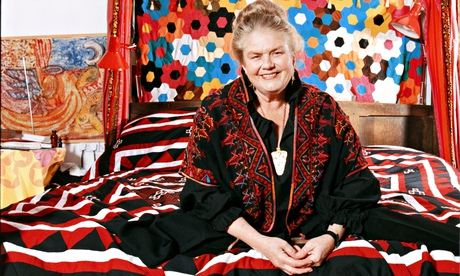
You don’t forget meeting Sheila Kitzinger. When I did two years ago, the gathered crowd of midwives, doctors and doulas practically stopped breathing for a moment as she entered the room. She was more than a hero to every pair of eyes that followed her stately progress to the stage. Resplendent in magenta, with a trademark feather in her hair, she spoke, in a voice that seemed made for rousing battle cries, about birth and sex until the young cameramen present were blushing deep scarlet. They shifted uncomfortably as she described “nipples becoming erect” in her characteristic, resonant tones.
Here was a woman, in her 80s no less, unafraid to confront the complexities of female sexuality on a daily basis. The world needs reminding of these all too regularly and for the past 50 or more years we’ve had Kitzinger there to do just that.
When I heard of her death I looked through my bookshelf, which is punctuated with her many books. Most striking is a painfully yellow booklet, Episiotomy: Physical and Emotional Aspects, published in 1981. It was written at a time when over half of UK women (and a much higher proportion of first-time mothers) were cut through the perineum during childbirth on the basis of little more than a ritualised obstetric whim.
In Episiotomy, Kitzinger is revolutionary in reminding those in the maternity services that “the feelings a woman has in labour cannot really be considered in isolation from other psychosexual aspects of her life”. That an operation on her genitals might impact on a woman beyond that moment of birth, and the detailing of how and why that might be, is reflective of the kind of work she did best. Her research and campaigning on this issue made a significant contribution to vastly reducing its use. Though 75% of women in Cyprus still get routinely cut during childbirth, less than 20% of UK women do.
Kitzinger’s work has been so wide-ranging and powerful that it is impossible to round it up briefly. For me, though, what unites her 30 books, many papers and wide-ranging commentary is her eloquent insistence that women’s experiences through pregnancy and parenting matter: during birth, yes, but crucially beyond that day, too. Prompted by a 20th-century maternity system that had increasingly turned childbirth into something that was done to women with a sterile barbarity, Kitzinger was relentless in her insistence that women needed to be put back at the centre of childbirth.
Many of the tributes to Kitzinger today use phrases such as “natural childbirth pioneer”. Of course, much of her work can be pigeon-holed that way if you want. But how quickly and easily the power of any discussion around childbirth is halved by doing just that. And she was interested in understanding the way women experienced birth without unnecessary interference, perhaps because she listened to women, many of whom understandably said they weren’t too keen on being routinely shaved, given an enema, drugged, cut and set about with forceps. But Kitzinger was no pusher of birth ideology.
She studied women and their real-life experiences, listening attentively as those changed over the decades. Her Birth Crisis helpline, often answered by Kitzinger herself, offered over-the-phone counselling to women who wanted to talk about their traumatic births. With all those divergent voices in her ears, she couldn’t reduce her message to a simple doctrine. She knew, and was not afraid to say, that the natural birth movement is problematic, too. In 2013 she said that she felt women were under pressure to “perform” during birth, to demonstrate all they had learned in their antenatal classes, and that birth had “become too goal orientated”. The word “natural” was one she felt was far too nuanced to use as an epithet synonymous with “good”. In fact, she said that we need to question “the idea that nature is always best”.
Kitzinger was a magnificent advocate for women but not a “natural birth” promoter. I believe she promoted one thing only: listening to and respecting women. For that we owe her much.

